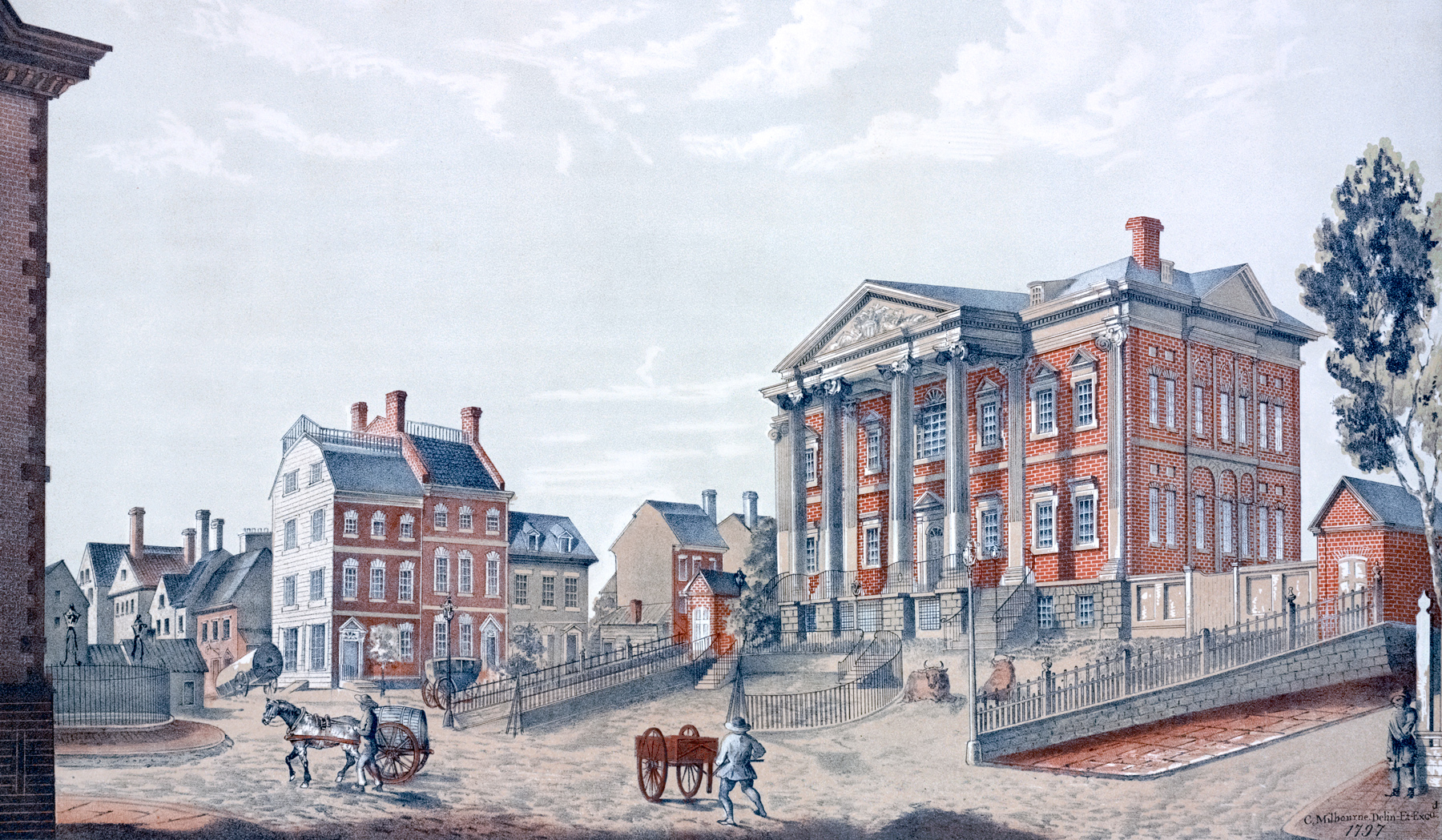
Government House in Bowling Green - 1797
Original title: The Government House. Text on print: This edifice was erected 1790, at the foot of Broad Way, facing the Bowling Green. "C. Milbourne. Delin-Et-Excud." Lithographed and published by H.R. Robinson (142 Nassau St. New York) from the original drawing by W.J. Condit in the possession of N. Campbell. Printed in colours by Wm. Ells. Copyrighted by H.R. Robinson in 1847. Source: New York Public Library.
It was originally built for the residence of General Washington (then President of the United States), but, the Capitol being removed, he never occupied it. It then became the Governors' House; and was the residence of Governors George Clinton and John Jay, until 1797, when the state capital was moved permanently to Albany.
In May, 1798, John Avery had leased the Government House and opened it as a boarding house and tavern by the name "The Elysian Boarding and Lodging House". The building was also used for the Custom House, from May 1, 1799 to 1815 (except from 1803 to about 1805). The Government House continued to be also used as a boarding house. A fire put it down in 1815. The State Street is on the right.
According to Stokes (Iconography of Manhattan Island... 1915), «The note in the lower left-hand margin, “From the original drawing by W. J. Condit,” may refer to the drawing on the lithographic stone, as the original water-colour bears the signature of Milbourne; or it may indicate that Milbourne painted the picture from a sketch by Condit». Still from Stokes, the building on the left is the number 1 Broadway, occupied at this time by Daniel Boardman, merchant. The original water-color has a window in the basement, the right jamb of which has been erroneously reproduced in the lithograph as the upright stone above referred to.
Continue below...

«The iron railing surrounding the Bowling Green, seen in the view, was built in 1771 to protect the statue of King George, which had been erected in the previous year. During the Revolution the small iron balls which adorned the fence at intervals were broken off by patriotic Americans and used as cannon balls, and the fence was partly broken down. It was repaired in 1786, and is still in existence.
The house on the south-east corner of Marketfield Street and Whitehall belonged, at the time when this view was drawn, to John Lasher, ‘‘Gentleman,” one of the prominent figures in the history of the city. On May 28, 1806, his son, John Bender Lasher, shipmaster, sold this corner house to Charles Duryee (...).
The house next to the corner, on Whitehall, was mortgaged February 15, 1775, by Matthias Bender, cooper, to the executors of Richard Waldron (...). It is described as “‘A Messuage, tenement, or dwelling house between the houses of John Lasher on the North and the heirs of John Waters on the South.” This shows Lasher’s house, as well as Bender’s, to have been in existence prior to 1775, but the date of their erection is not known. It is possible that both of these early houses had been demolished by Captain John Lasher and replaced by the large dwellings shown in the view. Matthew Bendor, of Acquacanonck, in the County of Essex, State of New Jersey, cooper, by his will dated July 27, 1779, bequeaths his lot on the Broadway adjoining John Lasher’s lot on one side and Daniel Evels’s lot on the other side unto his “good friend James Boggs.”(...). From the fact that there is no deed of record into either Bender or Lasher, and from the further fact that John Lasher named his son John Bender Lasher, it may be inferred that the property descended from an earlier Bender, the father of Matthew Bender and Mrs. John Lasher. The house bequeathed to James Boggs was conveyed by John Bender Lasher as a dwellinghouse to Jacob Levy, Jr., “Gentleman,” May 20, 1806».
|
Copyright © Geographic Guide - Old images of NYC. Historic Buildings. |
Government House in Bowling Green - 1797
